


Find foods you can eat.
Understanding Low FODMAP serving sizes
Published on March 5, 2021Why serving size matters on the low FODMAP diet
When it comes to a low FODMAP diet, portions do matter! If you’re just getting started on the elimination phase of the diet and not seeing the results you had hoped for, it’s possible you’re not paying enough attention to serving sizes. Many “low FODMAP foods” become high FODMAP at larger serving sizes. Click any ingredient in the Fig app to read more about its Low FODMAP serving size – and read on to learn more about deciphering portions on the Low FODMAP diet.
How to use the Monash app to determine low FODMAP serving sizes
Researchers at Monash University, the inventor of the Low FODMAP diet, routinely test foods to determine how much FODMAPs they have. They publish their results in the Monash FODMAP app which uses a traffic light system to identify high and low FODMAP foods and appropriate portion sizes.
Let’s take eggplant as an example. In the Monash app, there is a large green circle next to eggplant which means that it’s low FODMAP at a “typical” serving size. A typical serving size can be somewhat arbitrary, so it’s important to look at the smaller circles underneath the word eggplant. Here we see that eggplant can be moderate FODMAP (yellow) and high FODMAP (red) at larger serving sizes. During the elimination phase, Monash recommends that you consume “green”, limit “yellow”, and avoid “red” serving sizes.
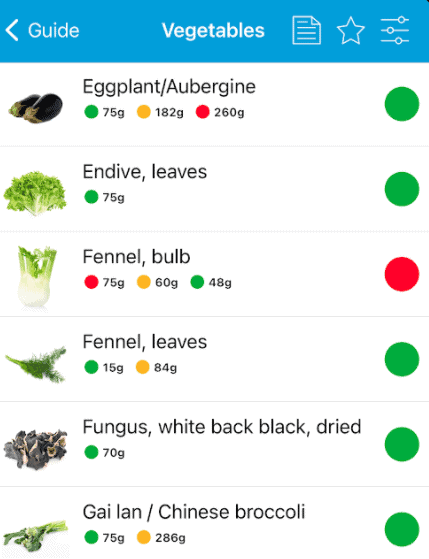
If we click into eggplant, we get more information about the serving sizes and types of FODMAPs present. You’ll see that eggplant is moderate FODMAP (yellow) in sorbitol at 2 ½ cups or 182 grams, and high in sorbitol (red) at 3 ½ cups or 260 grams. During elimination, you should stick with a portion size closer to 75 grams or 1 cup.
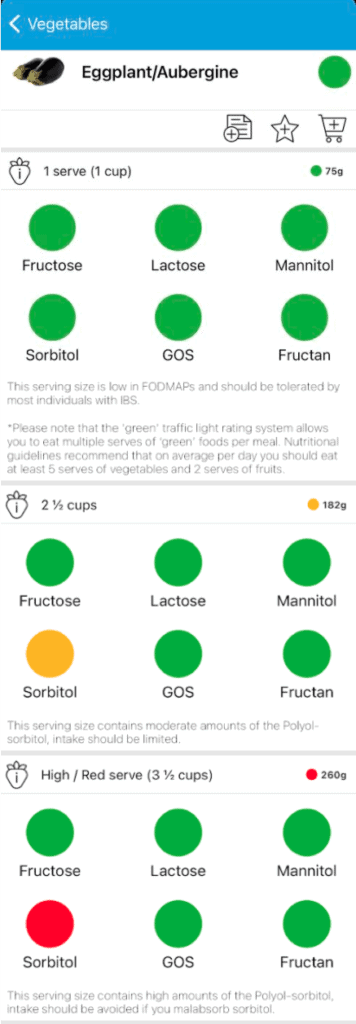
Cups and tablespoons versus grams for FODMAPs
The Monash app displays serving sizes both in volumetric amounts (cups, tablespoons, etc.) and weights (in grams). As a general rule of thumb, it’s better to use weights as your guide: just think about how much or little uncooked spinach you could fit into a standard measuring cup depending on how full you stuffed it!
If you do use weights, this certainly doesn’t mean you need to weigh all your foods; however, if you have a food scale, it can be helpful to use it for the first few days of the elimination diet. This helps give you a sense of what low FODMAP portion sizes look like.
If you don’t have a food scale, don’t worry. It’s fine to stick with the volumetric amounts using standard measuring devices you have at home. It’s important to note that the portion sizes in the Monash app refer to raw, uncooked foods unless specified otherwise. For example, if you look at spaghetti squash, it specifically states “cooked.”
Don’t forget to read the Monash footnotes!
Spaghetti squash is a great example of why it’s important to check for footnotes in the Monash app. Though cooked spaghetti squash only has green circles in the app, there are actually moderate FODMAP serving sizes of this food. The footnotes indicate that large servings (450 grams or 2 ½ cups) contain moderate amounts of Oligosaccharides.
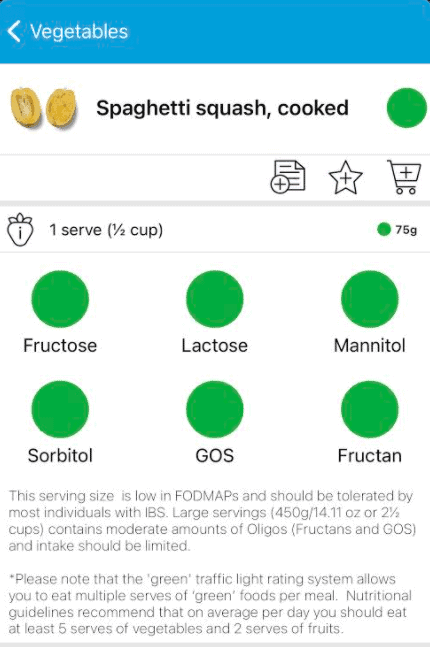
“Eat freely” foods in the Monash app footnotes
The footnotes aren’t all bad news, though! You’ll also find that some foods contain this sentence: “Eat freely and according to appetite.” This means that Monash didn’t detect any FODMAPs in these foods, and as the name suggests, you can truly eat however much of them you want. Carrots are a great example of an eat freely food. They have no FODMAPs.
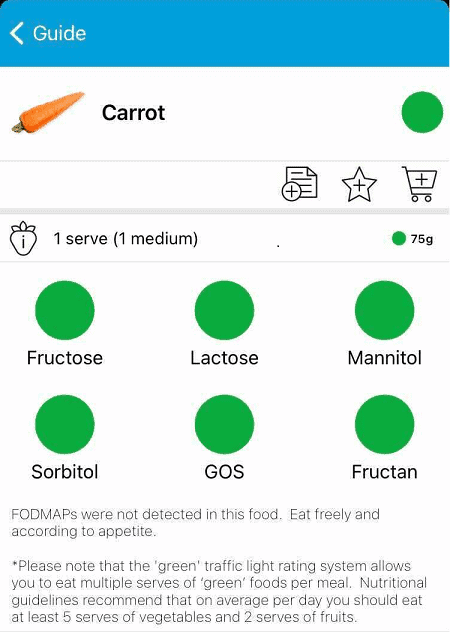
Mind your portions but don’t get overwhelmed
It’s important to be mindful of portion sizes, especially when first starting out on the diet, but it’s equally important not to become obsessive or stressed about portions. Stress itself can cause symptoms. If you are anxious about portion sizes, try to remind yourself you have some wiggle room. For example, if you eat 80 grams of spaghetti squash rather than 75 grams, it’s unlikely to push you over your threshold. But if you eat 450 grams at one time, then you are much more likely to experience symptoms.
Please remember that the low FODMAP diet is a learning diet with multiple phases. You should not stay on the elimination diet indefinitely, just for 2-6 weeks or until good symptom control is achieved. Once you move into the reintroduction phase, you can experiment with larger portion sizes. Your diet only needs to be as restrictive as your symptoms dictate. You may find that you can eat larger portion sizes of certain foods and tolerate them just fine!
Let Fig guide you on your FODMAP journey
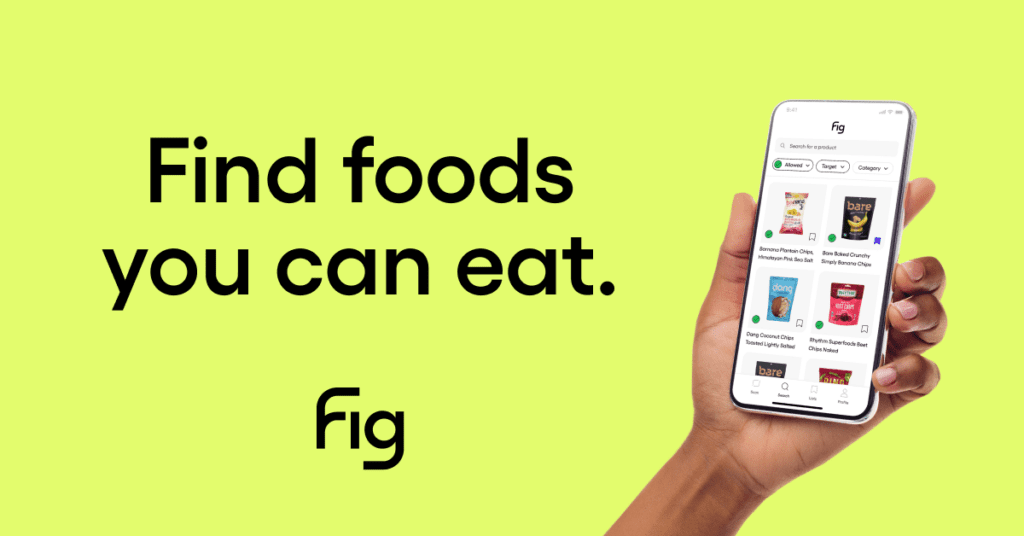
Fig’s phone app helps you find low FODMAP groceries! Simply tell Fig your dietary needs (Low FODMAP + anything else), and Fig will show you thousands of products that fit all those needs. Scan barcodes at the grocery store to see if products likely work for you.
Photo by August de Richelieu from Pexels
 Choosing a Low FODMAP Protein Powder
Choosing a Low FODMAP Protein Powder Alcohol on the Low FODMAP Diet
Alcohol on the Low FODMAP Diet